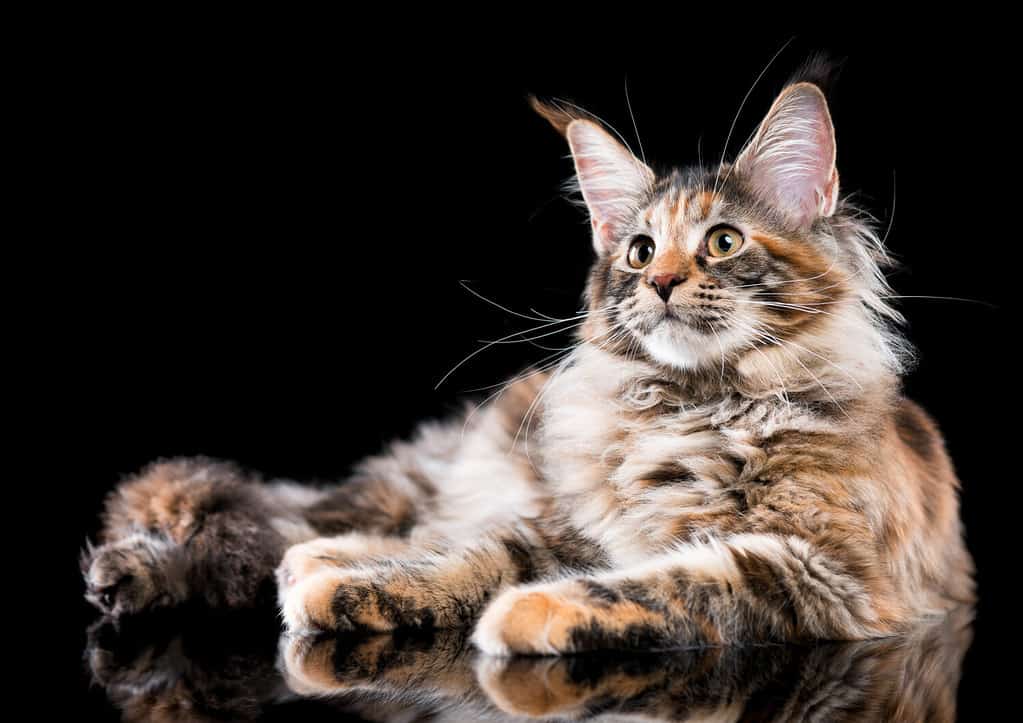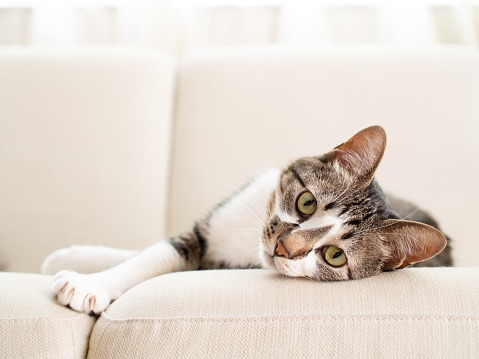According to research from the Animals Journal, 41% of cat owners keep their pets solely indoors. Of those 41% of owners, the vast majority (85%) choose to keep their cats indoors for purely safety reasons. So, do indoor cats really live longer than outdoor cats? What is an indoor cat’s lifespan?
Thanks to different factors and environmental enrichment, keeping a cat indoors can positively affect its health and well-being. Keep reading to discover just how long you can expect your indoor cat to live. If cats have nine lives, and they live them all indoors, you may have a pet for life!
Factors Influencing Indoor Cat Lifespan

Maine Coon
kittens are fluffy, but not among those with the longest lifespans.
©DenisNata/Shutterstock.com
Several different factors affect the lifespan of indoor cats, including breed, nutrition, exercise, and veterinary care.
Genetics
Some cats naturally have a heartier constitution, resulting in a longer lifespan if kept indoors. Cat breeds with the widely-accepted longer lifespans include:
- Russian Blue.
- Siamese.
- Ragdoll.
- Burmese.
- American short-haired cat.
In fact, the official record-holder for the oldest cat in history is an American shorthair (also known as domestic short-haired) cat that lived nearly 40 years. While there’s nothing inherently wrong with other breeds, these few purebreds have shown consistently long lives, with many living into their teen years and beyond. Funnily enough, the “seven-year rule” for dogs — that a dog’s age is its year times the number seven, differs a bit for cats. A one-year-old cat is closer to a 17-year-old according to the Connecticut Science Center.
Like dogs, purebred cats can have some hallmark health issues of their breeds, like Persian cats being brachycephalic or Bengals having progressive retinal atrophy in their older age. As such, a mixed breed may live longer — or at least have the proclivity to — than their purebred counterparts.
Nutrition and Diet
The Purina Institute recently conducted a nine-year study focusing on the longevity of felines. Its main highlights found that nutrition plays a key role in extending the healthy life of cats. Over nearly a decade of feeding 90+ pure and mixed breeds — broken into a control group and two other groups — found that blends of vitamins and macronutrients can significantly affect the longevity of an indoor cat. Specifically, a nutrient blend with antioxidants, essential fatty acids, and a prebiotic can extend the lives of cats.
One of the main things to remember about an indoor cat’s lifestyle when compared to an outdoor cat is their activity level. Often, outdoor cats run, jump, chase, and sneak around across a large expanse of nature. While indoor cats may perform the same actions, they’re doing it in a significantly smaller space on a smaller scale. Because they don’t burn as many calories, feeding them the correct food to maintain a proper, healthy weight is key.
Cat food should always include protein. Other inclusions will vary based on the food’s specific use — like beet pulp for hairball reduction or pre- and probiotics for digestion.
Exercise and Physical Activity
As mentioned above, indoor cats don’t get near as much exercise as outdoor cats, meaning they won’t burn calories as quickly. The key to maintaining and extending your indoor cat’s lifespan comes down to exercise and activity after their genetics and diet.
Regular exercise will look different for every cat, but it may consist of:
- Leashed outdoor walks.
- Playing with other pets.
- A pre-built indoor exercise tower.
- Interactive games and toys.
- Puzzle feeders and treat boxes.
- Outdoor enclosures.
Not all cats will enjoy an outdoor walk, but a “catio” or outdoor cat enclosure gives your indoor cat a safe taste of the outdoors. Playing with other pets — be it another cat, a dog, or a bunny — is a great use of energy that doesn’t take time out of an owner’s day. However, ensure your pets play safely together and never leave them unsupervised for an extended period of time.
Puzzle feeders or puzzle boards with treats can mentally stimulate your cat, but they won’t give them as much physical exercise as an exercise tower. Whatever exercise routine you choose to entertain your cat with, make sure to switch it up every now and then for maximum enjoyment.
Exercise can prevent obesity and its related health issues (like diabetes, cancers, metabolic diseases, respiratory diseases, and heart diseases) in your indoor cat. Not to mention, your cat will weigh less if they’re not obese — meaning they’re much easier to pick up and snuggle!
Veterinary Care and Preventive Measures
After their kitten stage, adult cats will need regular vet check-ups and vaccinations to ensure they remain healthy.
Preventive measures can extend a cat’s lifespan by months or years, especially if they’re purebred cats and the vet catches warning signs of a certain condition early enough. In addition, veterinary care means the choice to spay or neuter and get vaccinations. If you choose to board your cat at a pet resort, many will require vaccinations.
Going to the vet also ensures you’ll stay aware of the common health issues in indoor cats and how to address them if they happen to your feline friend. The most common issues that indoor cats weather include:
- Periodontal disease.
- Obesity.
- Diabetes.
- Lower urinary disease.
Don’t forget about hairballs, too! While not immediately concerning, an increase in hairball production or more than one a week may set off an alarm to see the vet soon.
Environmental Enrichment

Burmese cats, along with others, benefit from enrichment like fake mice toys.
©scaliger/iStock via Getty Images
Mental stimulation remains important for indoor cats. If they get bored, indoor cats will become destructive — like terrorizing other pets, overeating their food, peeing outside of their litter box, destroying furniture, and over-grooming themselves.
Calling back to the toys you bought for your cat to exercise them: ensure they’re readily available for your cat to entertain themselves with at any time! Interactive puzzles and feeder toys are great for mental stimulation and environmental enrichment. Interactive toys, like robotic mice or fish that move on their own, will keep your cat occupied for hours and safely feed their predator drive. These automated toys also help a cat learn to entertain themselves. If introduced to the toys around their owners, and played with several times under supervision, these automated toys are great choices for when you leave home and need to keep your cat occupied with something.
Outside of toys and enriching activities, cats need a safe indoor living space. Scratching posts and climbing trees make wonderful use of vertical space in a home. Instead of clambering over upholstery and furniture, towers make a great jungle gym — and are specifically designed to hold a cat’s weight. Hide treats in the alcoves of your indoor cat’s tower to give them a special surprise. They may even accept it as a treasure hunt and look forward to more activities like it.
Stress and Anxiety Management

If stress and anxiety aren’t treated, cats will over-groom themselves.
©Konstantin Aksenov/iStock via Getty Images
Outside of obesity, stress and anxiety management in cats remains an important factor in extending an indoor cat’s lifespan. Cats become stressed from many things, including:
- Other pets in the home.
- Separation from you or their favorite human.
- External forces (like animals outside).
- Guests or visitors to the house.
- Unclean or not provided resources.
Just like in humans, stress can shorten life expectancy. Indoor cats with a greater amount of stress or anxiety may contract heart conditions, develop high blood pressure, or learn behavioral flight responses that place them in harm’s way.
Overall, managing indoor cat stress comes down to identifying triggers and supplying solutions. If your cat hates being picked up, don’t pick up your cat — even if they do look adorable. Maybe the neighbor’s barking dogs put your cat on edge, so try to play some calming music during the day to drown out the noise. If guests coming over stress your cat out, create a comfortable and calming corner of the home your cat can escape to that guests aren’t allowed near. As with many cat behaviors, it’s a balancing act of what they want versus what will keep them safest.
Human-Cat Bonding to Reduce Stress
Contrary to popular belief, cats do have — and show — affection for their owners. They see their owners as a source of food, comfort, and security. As every cat is different, they’ll enjoy being shown affection and bonding with their owners in different ways. Creating a strong bond with your cat ensures they’ll continue to see you as safe and run toward, not away, from you when something they perceive as dangerous appears in their space.
Many cats prefer not to be handled and will become aloof if picked up in the wrong spot. For owners to bond with their cats and provide them with an enriching, symbiotic relationship, they should listen to what their cat wants and needs. Try to give your indoor cat the space and independence the species loves — but attempt to bond and engage with them as well to strike a balance.
Furthermore, where you pet a cat might make or break your relationship. Overall, cats like scratches on the chin and behind the ear. Most aren’t similar to dogs and want butt scratches and belly rubs. Quite the opposite, actually: studies show that cats become more wary of people who scratch or pet these spots on their bodies.
Indoor vs. Outdoor Cats: Comparing Lifespans

On average, indoor cats will live 10 years longer than outdoor cats.
©kaorinne/iStock via Getty Images
Did you know that indoor cats have a significantly longer lifespan than outdoor cats? Some estimations give the cats a 10-year difference: indoor cat life spans the range between 10 to 15 years while outdoor cat life spans are only two to five years.
Some of the main concerns for outdoor cats’ roaming include:
- Wandering into the street and getting struck by a car.
- Roaming too far and getting lost.
- Wildlife or neighborhood dog encounters that result in injury or death.
- Picking up parasites, fleas, or worms they can pass onto other members of the family.
- Exposure to the elements.
- Getting trapped in tight spaces or neighboring property and being unable to escape.
Cats can live exciting lives outside, but the reality of their outdoor existence is fleeing near-constant danger. Living inside affords cats the autonomy of a space to explore with the safety of a comfortable environment they can make their own.
Taking Great Care of Your Indoor Cat Extends Its Life
While indoor cats have inherently longer lives than their outdoor counterparts, it all comes down to responsible cat ownership. Feeding them proper nutrition, supplying them with enriching environments and exercise, and providing annual veterinary care will ensure a long, healthy, and happy life for your indoor cat.
Next up, discover the cats with the longest lifespans, secrets of a cat’s meow, or some of the best litter for even the pickiest felines.
The photo featured at the top of this post is © pthiofanni/Shutterstock.com
Thank you for reading! Have some feedback for us? Contact the AZ Animals editorial team.






